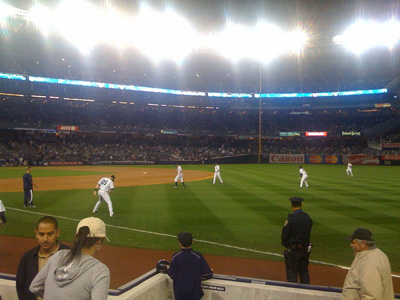On Tuesday night, I had the quite the treat. Not only did I attend an exciting (if rather meaningless) Yankees victory — complete with made-to-order Kyle Farnsworth meltdown — with friend and colleague Steven Goldman, but thanks to a connection on the inside, we had a view from the so-called Legends seats down the right field line. Section 11, Row 6 if you’re keeping score. My lone pic, taken during the pregame warmup:

Now, I certainly have my reservations and criticisms about the excesses of Yankee Stadium III, but I was in no position to refuse a complementary glimpse into this little world of indulgence. Steve wrote about his experience at the Pinstriped Bible, but because he was late for the game due to travel difficulties, I gained a slightly different perspective on the pregame accommodations by dining at the all-you-can eat buffet in the Legends Suite club, where the food was considerably better than the chicken nuggets and french fries he availed himself of later in the evening. Without resorting to sheer gluttony, I did sample five different meat offerings (pork loin, veal, beef ribs, mini kielbasa, and something called a foie slider), though I eschewed the tantalizing sweets that were on offer save for one chocolate-covered strawberry. The veal (which I had selected thinking was pork shoulder) was terribly dry, a sad failure to honor the protein, and the slider was just a rather nondescript, dry little burger, but the pork was much better, and the ribs, which had a pleasantly sweet Asian-style glaze, were outstanding. Remembering Steve’s sage advice about eating scampi or sushi prepared in the bowels of the previous Yankee Stadium, I steered entirely clear of the seafood, though I must admit that the seared scallops that went by me looked quite tempting.
Thus sated, I didn’t need to further gorge myself while seated (as several around us did) or in the smaller Ketel One Lounge behind our section. After I took out a second mortgage to pay for the one beer I ordered at my seat (alcohol was the only cash outlay on my part for the entire evening), I went light on the whole service aspect of things
With the Yankees having clinched the AL East flag and home field advantage two days earlier against the Red Sox — a game I also attended, viewing from my regular peanut gallery seats — attendance was sparse, particularly in these seats. I’d estimate our section, which was the furthest one down the right field line, was about one-third capacity, and I was clearly the only one with a scorebook (some habits die hard). The majority of the male constituents in our vicinity were at the very least dressed in business casual attire. The two gents next to me still had their ties on, and the gin-soused boor who was ejected for harassing the security guard (see Steve’s writeup) was wearing a suit, not to mention a particularly horseshit pink-and-purple tie that did not go unremarked-upon by yours truly from down in his cups once said boor was in NYPD custody. In comedy, timing is everything.
The game itself was an exciting affair despite the low stakes. A.J. Burnett was fairly sharp, as was Royals starter Anthony Lerew, providing for a brisk pitcher’s duel over the first six innings. The Royals scratched out a run in the third and the Yanks knotted the score in the sixth off a Mark Teixeira solo shot. Things got more hectic in the seventh, when Burnett walked leadoff hitter Mark Teahen and reliever Phil Coke suddenly forgot how to field his position, failing to make a play on a bunt single and making a throwing error one batter later, all leading to two runs.
Lerew’s night ended when Nick Swisher led off the home half of the seventh with a solo homer, but by the time the Yankees mounted their rally against Farnsworth (charged with closing because ace Royals closer Joakim Soria had thrown 46 pitches the day before), the B team was in. With one out, third-string catcher Francisco Cervelli beat out an infield hit, then Eric Hinske, hitting for Ramiro Peña (who’d started at second base) singled him to third base, and Robinson Cano, pinch-hitting for Derek Jeter, tied the game with a sacrifice fly. Hinske did a double bellyflop on a busted hit-and-run, sliding into second base safely on his ample gut, then again after taking third when the throw dribbled into center field. Johnny Damon was intentionally walked, and then rookie first baseman Juan Miranda lined a shot off the eternally hapless Farnsworth’s leg. The ball rolled into foul territory on the first base side as Hinske scored, and a pack of rabid Yankees ran down Miranda, who got his obligatory whipped cream pie in the face during the postgame interview. Fun stuff for the kid as the Yankee scrubs beat the Royal schlubs.
All in all, it’s clear I could never get used to wallowing in such luxury during a ballgame. As the ejected boor’s go-work-at-McDonalds tirade illustrated, the class distinctions between the patrons and the employees in the Legends seating area are laid all too bare, at least for my tastes. I won’t snub a freebie to get beyond the velvet rope once in a blue moon, but all things considered, I’m much happier paying my twenty bucks to sit in the nosebleeds and standing in line for my beer.

